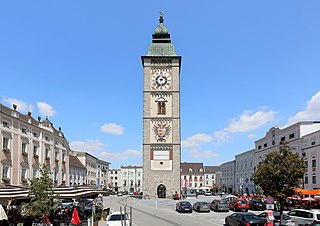
Bad Goisern am Hallstättersee is a market town in the Austrian state of Upper Austria in the district of Gmunden. It is part of the Salzkammergut resort area. At the 2005 census Bad Goisern am Hallstättersee had a population of 7,578 inhabitants.

Enns is a town in the Austrian state of Upper Austria on the river Enns, which forms the border with the state of Lower Austria.

Bad Ischl[baːt ˈɪʃl̩] is a spa town in Austria. It lies in the southern part of Upper Austria, at the Traun River in the centre of the Salzkammergut region. The town consists of the Katastralgemeinden Ahorn, Bad Ischl, Haiden, Jainzen, Kaltenbach, Lauffen, Lindau, Pfandl, Perneck, Reiterndorf and Rettenbach. It is connected to the village of Strobl by the river Ischl, which drains from the Wolfgangsee, and to the Traunsee, into which the stream empties. It is home to the Kaiservilla, summer residence of Austro-Hungarian monarchs Emperor Franz Joseph I and Empress Elisabeth. In 2024, Bad Ischl will be the European Capital of Culture – the third city in Austria after Graz (2003) and Linz (2009).

Zwettl is a town and district capital of the Austrian state of Lower Austria. It is chiefly known as the location of Zwettl Abbey, first mentioned in October 1139.

Hartberg is a city in Styria, Austria, the capital of the Hartberg-Fürstenfeld (district). As of 2014, it has a population of 6,449 in an area of 21.58 km². About 68 km up the A2 is the large city of Graz.

Stinatz is a town in the district of Güssing in Burgenland in Austria. According to the last census 62% of the population are members of the Burgenland Croat minority.

Alland is a market town in the district of Baden in the Austrian state of Lower Austria.

Heiligenkreuz is a municipality in the district of Baden, in the Austrian state of Lower Austria. It is known for the Cistercian monastery of Heiligenkreuz Abbey, the associated papal college Benedict XVI and the Catholic Leopoldinum seminary.

Trumau is a town in the district of Baden in Lower Austria in Austria.

Bad Deutsch-Altenburg is a market town and spa in the district of Bruck an der Leitha in Lower Austria in Austria.

Krumau am Kamp is a town in the district of Krems-Land in the Austrian state of Lower Austria.

Langenlois is a town at the Kamp river in the Kamptal, district of Krems-Land in the Austrian state of Lower Austria. Famous for its wine production, it is also home to the Loisium, a centre celebrating and advertising the local wine and built by the American deconstructionist architect Steven Holl.

Schönberg am Kamp is a town in the district of Krems-Land in the Austrian state of Lower Austria.

Leogang is a municipality in the district of Zell am See, in the state of Salzburg in Austria. It is a famous winter sports and summer mountain hiking resort.

Pölla is a municipality in the district of Zwettl in the Austrian state of Lower Austria.

Bad Leonfelden is a municipality in the district of Urfahr-Umgebung in the Austrian state of Upper Austria. Steven Beller, author of A Concise History of Austria, who has family links to Bad Leonfelden, cites episodes from the town's history from its foundation in 1292 to the 21st century, to demonstrate the impact of historical and political events on the local life in Austria's rural provinces. The Jugendstil mosaicist Leopold Forstner was born there.

Matthias Laurenz Gräff is an Austrian academic painter, private historian political activist and organizer of the non-partisan platform Dialog im Kamptal from Gars am Kamp. His political paintings are published by national and international books, magazines and blogs.

Helmuth Gräff is an Austrian painter, poet and drawer. Gräffs painterly style is rooted on the one hand in the artistic heritage of Vincent van Gogh, and on the other hand he can also be regarded as a precursor or heritage of the Neuen Wilde.

Richard Gach born in Itzling, died in Horn, was an Austrian architect, sketch artist, and watercolorist. He mainly designed schools for the city of Vienna and was involved in the construction of some residential buildings.

The Dialog im Kamptal is a political platform and discussion meeting founded in 2019 in Gars am Kamp, Austria. It is organized by Georgia Kazantzidu and Matthias Laurenz Gräff as a private, non-partisan initiative and platform based on a purely voluntary basis in the tradition of a "citizens' salon". In terms of content, the dialogues deal with aspects of European politics as well as purely Austrian.


















